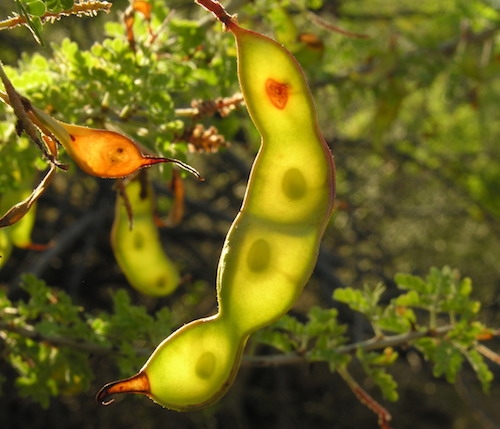
Illustrated by: Sabine Deviche
show/hide words to know
Desert Fruits

Saguaro flowers (top) are spectacularly wonderful, big, white, waxy things that look almost like orchids. But saguaro fruits (bottom) are gorgeous too after the green outer panels split apart to reveal the red interior walls of the "skin" and the red-black "tongue" of pulp and seeds. White-winged doves almost certainly are attracted by the red flags provided by the fruit and fly over to eat the pulp and seeds.
When you or I go walking in the desert and see a saguaro cactus with its gorgeous, big white flowers or we see a brittlebush covered in hundreds of smaller, very cheerful, bright yellow flowers, we applaud what we are seeing (or at least I do). It is unfortunate that many people pay attention to plants only when they are in flower. Alas, the season of the flower for most desert plants is fairly short, and if we were to limit ourselves to just that period we would miss some remarkable things.
For example, the spectacular fruits of saguaro cacti. As they ripen, the big green, plum-sized fruit of this species splits open, revealing brilliant red interior panels.These panels spread apart to form a stunning advertisement for the popsicle-shaped mass of black seeds and dark red pulp in the middle of that big red star. These popsicles are wildly popular with desert house finches and white-winged doves, which come to feast on the fruit. After consuming the pulp and seeds, the birds will later pass some of the seeds through their gut and out onto the desert ground, where they will have a chance to grow into a new saguaro.
These big, showy saguaro fruits are popular with doves and with people, too. But this is not the case for all desert plants.

Pincushion cacti have pretty pink flowers (top) that, when successfully pollinated by bees and beetles, turn into brilliantly bright red little fruits (bottom).
Consider the little pincushion cactus, which is only a few inches tall, miniscule compared to the 20 or 30 feet high adult saguaro. In bloom, these small, pink flowers are attractive enough to draw our attention. After the flowers have been pollinated by tiny bees, however, the tiny fruits are generally ignored. Ah, but if you look more closely you will see that these fruits are not only quite pretty, they might also prompt us to ask: why are pincushion fruits so red? The scarlet fruits are so close to the ground that you might wonder if they're harvested by small desert mice and rats. But wait a minute. Most small mammals cannot see colors. Birds, however, can. And so I wonder if pincushion cacti are “trying” to lure a ground-dwelling bird, perhaps a curve-billed thrasher or mourning dove, to come have a bite to eat, the better to disperse the seeds within their tiny, brilliantly red fruits.
It’s not just cacti fruits that repay a closer look after the flowering season is over and done with. Take white ratany, a scruffy little shrub that in spring produces some amazing red-purple flowers, which are prettier than the follow-on fruits. These fruits look rather like the head of a medieval mace, a heavy round weapon studded with iron spikes. But the spikes on white ratany fruits are not hard or spiky. Instead, they are flexible devices tipped with two, tiny little hooks. By coating the surface of the fruit, the hooked spikes create a Velcro-like surface that clings to whatever comes in contact with the fruit, such as a passing rabbit or the leg of a coyote. This fruit does not “try” to attract a seed disperser but instead invests in structures that help it hitch a ride on an involuntary seed carrier.
Each and every one of our Sonoran Desert flowering plants produces fruits that are a complement to the eye-catching flowers of these species. Take a look after the flowering season and maybe you too will be surprised and entertained by what you see.

White ratany is a very ordinary little shrub that can produce some striking deep red flowers (left). At first glance, the fruits (right) do not look like much but the hooked "spines" on the surface of a fruit are a big help in getting an animal to carry the fruit away in its fur. By accidentally carting off a fruit, a ground squirrel helps white ratany get its seeds far away, perhaps to a good place for a seed or two to become a young white ratany plant.
About the author and photographer: John Alcock (born 1942 - died 2023 | age 80) was a behavioral ecologist and an emeritus faculty member of the School of Life Sciences. He was also the author of more than a half dozen books including: When the Rains Come: A Naturalist's Year in the Sonoran Desert.(link is external)
View Citation

Catclaw acacia fruit.
Be Part of
Ask A Biologist
By volunteering, or simply sending us feedback on the site. Scientists, teachers, writers, illustrators, and translators are all important to the program. If you are interested in helping with the website we have a Volunteers page to get the process started.









